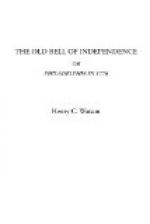“It was debated in the garrison, whether it would be a point of prudence to hazard a sally. An officer, who had been at the enemy’s camp with a flag, opposed it, as did also Colonel Dennison and several others, and Colonel Butler rather declined it; but, among others who were in favor of it, a certain captain, (who never lived to lament his temerity,) urged it with so much vehemence, that the commandant consented. A Mr. Ingersol, then in the garrison with a flag from the enemy, had been some time their captive, and was intimately acquainted with their strength. He did his utmost to deter them from the rash attempt, but all in vain; and, when he saw them turn out and parade, could no longer refrain from tears.
“The third day of July, in the year 1778, was the fatal day that deluged in blood the plains of Wyoming! The garrison marched off in a solid column, and met with no material obstruction till they reached the enemy’s camp, about three miles above Forty Fort. Here they had the Susquehanna on the right, and a thick swamp on the left; and, perceiving that the enemy extended from the one to the other, ready to receive them, they displayed column, which threw them into a similar position. Colonel Zebulon Butler commanded the right, and was opposed by Colonel John Butler, on the enemy’s left. Colonel Dennison commanded on the left, and was opposed by Colonel Brandt, on the enemy’s right. The action commenced at about forty rods distance. The air being heavy, the smoke obstructed their sight; and, after the first discharge, they could only direct their aim by the flash of the enemy’s guns. Little execution was done till after several discharges. Brandt marched a party into the swamp, and flanked the militia. The enemy, now firing from under cover of the thicket, greatly annoyed that wing. The militia dropped down very fast, and at length began to give way, one after another, in rapid succession, till the rout became general. The fugitives were closely pursued by the Indians, who, besides their rifles and tomahawks, were provided with long spears, which they threw with great dexterity, and seldom missed their object—the practice of throwing the tomahawk and spear, and of taking aim, being the principal exercises to which an Indian warrior is trained.
“It was impossible for men thus flying and thus pursued to rally, nor had they a moment’s time even to load their pieces, while death was close upon every man’s heel. And, besides, many of them had no other weapon but a rusty musket. Flight was their only hope; and the Indians, being most accustomed to running, if they could not run the fastest, could, however, out-wind them. The carnage at once became general, and three-fourths of the militia were killed.




